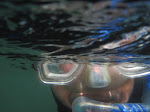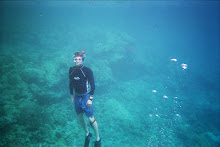I underestimated this book when it first came out, annoyed and distracted by the childishness (I thought) of the cover; also, I had thought the book a fictional fantasy of human-cetacean bonding. In fact, Grayson is a true account, well described, of the 17-year-old Cox's encounter with a seemingly lost baby whale during one of her usual training swims at Seal Beach, California, and of her efforts to swim with the whale, leading it away from the beach and the possibility of a fatal grounding, and to find the whale's mother . . . all while swimming. No boat, no jetski, no kayak, no surfboard, no airplane, no helicopter--and no wetsuit. Cox swims and swims and swims with the baby gray whale. As she describes all that water-time, we get vividly rendered scenes of swimming amidst schools of anchovies, with grunion, with tuna, with bat rays, with dolphins, and whales. Yes, the mother whale arrives to collect her errant offspring, and Cox heads for shore after about three hours in those rather chilly waters off Seal Beach. A well-told tale: I am glad that I have now read it, and I will give copies to family and friends as presents in the future.
This book could be a good English 90 or 92 text.
---. Swimming to Antarctica: Tales of a Long-Distance Swimmer. New York: Harcourt, 2005.
I discovered Cox's aquatic autobiography late in 2008, though I don't know how I had overlooked it before that. I love stories of open water swimming and of the strength of body, mind and spirit that such a pursuit demands. Jenifer Levin's novel Water Dancer has been a favorite novel on this topic for the last 25 or so years of my life--and I still love and prefer that novel to this book--but Swimming to Antarctica has the definite advantage of being non-fiction, of being a set of true tales. (I say "advantage" because students often prefer the non-fiction, the documentary, over stories that are merely made up. Fiction has its own advantages.) Cox is a very determined individual, more positive thinking than anyone I know, and with the life experiences and adversity to back up her positive modeling.
I recommend this book, and I started recommending it before I even finished it, as I read through that first chapter. I am now recalling the chapter in which Lynne Cox sets a record for crossing the English Channel at age 16, and I am wanting to know more; I want to reread now. Where's my copy of Swimming to Antarctica?
(Isn't that the best response to any book?)
























